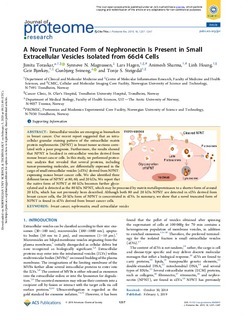| dc.contributor.author | Toraskar, Jimita Prashant | |
| dc.contributor.author | Norvoll Magnussen, Synnøve | |
| dc.contributor.author | Hagen, Lars | |
| dc.contributor.author | Sharma, Animesh | |
| dc.contributor.author | Hoang, Linh | |
| dc.contributor.author | Bjørkøy, Geir | |
| dc.contributor.author | Svineng, Gunbjørg | |
| dc.contributor.author | Steigedal, Tonje S. | |
| dc.date.accessioned | 2020-02-05T09:23:10Z | |
| dc.date.available | 2020-02-05T09:23:10Z | |
| dc.date.created | 2019-03-13T13:24:35Z | |
| dc.date.issued | 2019 | |
| dc.identifier.citation | Journal of Proteome Research. 2019, 18 (3), 1237-1247. | nb_NO |
| dc.identifier.issn | 1535-3893 | |
| dc.identifier.uri | http://hdl.handle.net/11250/2639720 | |
| dc.description.abstract | Extracellular vesicles are emerging as biomarkers in breast cancer. Our recent report suggested that an intracellular granular staining pattern of the extracellular matrix protein nephronectin (NPNT) in breast tumor sections correlated with a poor prognosis. Furthermore, the results showed that NPNT is localized in extracellular vesicles derived from mouse breast cancer cells. In this study, we performed proteomic analysis that revealed that several proteins, including tumor-promoting molecules, are differentially expressed in the cargo of small extracellular vesicles (sEVs) derived from NPNT-expressing mouse breast cancer cells. We also identified three different forms of NPNT at 80, 60, and 20 kDa. We report that the native form of NPNT at 60 kDa becomes further glycosylated and is detected as the 80 kDa NPNT, which may be processed by matrix metalloproteinases to a shorter form of around 20 kDa, which has not previously been described. Although both 80 and 20 kDa NPNT are detected in sEVs derived from breast cancer cells, the 20 kDa form of NPNT is concentrated in sEVs. In summary, we show that a novel truncated form of NPNT is found in sEVs derived from breast cancer cells. | nb_NO |
| dc.language.iso | eng | nb_NO |
| dc.publisher | American Chemical Society | nb_NO |
| dc.relation.uri | https://pubs.acs.org/doi/ipdf/10.1021/acs.jproteome.8b00859 | |
| dc.title | A Novel Truncated Form of Nephronectin Is Present in Small Extracellular Vesicles Isolated from 66cl4 Cells | nb_NO |
| dc.type | Journal article | nb_NO |
| dc.type | Peer reviewed | nb_NO |
| dc.description.version | publishedVersion | nb_NO |
| dc.source.pagenumber | 1237-1247 | nb_NO |
| dc.source.volume | 18 | nb_NO |
| dc.source.journal | Journal of Proteome Research | nb_NO |
| dc.source.issue | 3 | nb_NO |
| dc.identifier.doi | 10.1021/acs.jproteome.8b00859 | |
| dc.identifier.cristin | 1684472 | |
| dc.relation.project | Notur/NorStore: NS9036K | nb_NO |
| dc.description.localcode | This is an open access article published under an ACS AuthorChoice License, which permits copying and redistribution of the article or any adaptations for non-commercial purposes. | nb_NO |
| cristin.unitcode | 194,65,15,0 | |
| cristin.unitcode | 194,66,40,0 | |
| cristin.unitname | Institutt for klinisk og molekylær medisin | |
| cristin.unitname | Institutt for bioingeniørfag | |
| cristin.ispublished | true | |
| cristin.fulltext | postprint | |
| cristin.fulltext | original | |
| cristin.qualitycode | 2 | |
